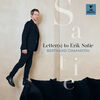Letter(s) to Erik Satie
Bertrand Chamayou
Classical - Released September 1, 2023 | Warner Classics
Gabi Hartmann
Gabi Hartmann
Vocal Jazz - Released January 13, 2023 | Masterworks
Getz/Gilberto #2
Stan Getz
Jazz - Released January 1, 1966 | Verve
Afrikan Culture
Shabaka
Jazz - Released May 20, 2022 | Impulse!
Bande Originale du jeu vidéo "Assassin's Creed" (2007)
Jesper Kyd
Video Games - Released November 14, 2007 | Ubisoft Music
La planète sauvage
Alain Goraguer
Film Soundtracks - Released January 1, 1973 | Universal Music Division Decca Records France
10 Years Solo Live
Brad Mehldau
Jazz - Released October 16, 2015 | Nonesuch
Tchaikovsky
Daniel Lozakovich
Classical - Released October 18, 2019 | Deutsche Grammophon (DG)
Herrmann: Suite from Wuthering Heights, Echoes for Strings
Singapore Symphony Orchestra
Opera - Released June 30, 2023 | Chandos
The Astrud Gilberto Album
Astrud Gilberto
Jazz - Released June 8, 2023 | Verve Reissues
Meditations
Cory Wong
Jazz - Released May 29, 2020 | Cory Wong and Jon Batiste
The Paisley Park Session
Cory Wong
Jazz - Released October 29, 2021 | Roundwound Media, LLC.
Blue Eye Samurai (Soundtrack from the Netflix Series)
Amie Doherty
Film Soundtracks - Released October 27, 2023 | Netflix Music
Mari
Mari Samuelsen
Classical - Released June 7, 2019 | Deutsche Grammophon (DG)
Ambient 3 / Day Of Radiance
Laraaji
Electronic - Released January 1, 1980 | EMI Catalogue
Just Between Friends
Houston Person
Bebop - Released May 6, 2008 | HighNote Records
Sinatra/Jobim: The Complete Reprise Recordings
Frank Sinatra
Jazz - Released January 1, 2010 | FRANK SINATRA DIGITAL REPRISE
Méditation
Andreas Staier
Classical - Released February 2, 2024 | Alpha Classics
Charles Koechlin : Orchestral Works
Heinz Holliger
Symphonic Music - Released October 13, 2017 | SWR Classic
The Astrud Gilberto Album
Astrud Gilberto
Jazz - Released June 8, 2023 | Verve Reissues






















 Suppose you have a more precise idea of what you want. If you are searching for the album "Bad" by Michael Jackson, type michael jackson bad. The album in question will be displayed at the top, as it is the most relevant.
Suppose you have a more precise idea of what you want. If you are searching for the album "Bad" by Michael Jackson, type michael jackson bad. The album in question will be displayed at the top, as it is the most relevant.
 By default, search results are sorted in order of relevance. The drop-down menu to the right of "Sort by" allows you to display the results in the desired order.
By default, search results are sorted in order of relevance. The drop-down menu to the right of "Sort by" allows you to display the results in the desired order.